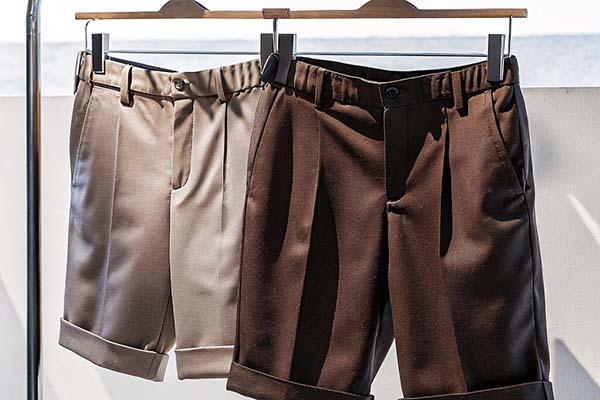Shorts are an everyday wardrobe essential, especially in warm weather. However, the name “shorts” often raises a curious question: why are they called “shorts” instead of simply “short”? While the answer may seem straightforward, it has roots in language, history, and fashion evolution.
The term "shorts" is a plural form derived from “short pants1,” indicating their shortened length compared to full-length trousers. The name reflects their design as a pair of garments for the legs.
In this article, we’ll dive into the origins of the term “shorts,” their historical evolution, and how language shaped their plural form.

What Were Shorts Originally Called?
Shorts, as we know them today, have evolved significantly over time. The name “shorts” didn’t always exist, and earlier variations of the garment had different names based on their style and purpose.
Early Names for Shorts
- Breeches2: In the 16th century, men wore knee-length trousers called breeches, which could be considered an ancestor of modern shorts.
- Knickerbockers3: In the 19th century, these baggy, knee-length pants were popular, particularly for sports and leisure.
- Short Pants1: By the early 20th century, children’s clothing often included “short pants,” leading to the abbreviated term “shorts.”
Key Insight: The transition from “short pants” to “shorts” reflects a linguistic trend of simplification over time.
Why Are Shorts Plural?
The plural form “shorts” stems from the fact that they are considered a pair of garments, similar to trousers or pants.
1. Historical Language Influence
The English language often uses plural forms for items that come in pairs:
- Pants: Refers to a pair of garments covering both legs.
- Glasses: Describes a pair of lenses for the eyes.
Shorts follow the same pattern, emphasizing their dual-leg design.
2. Design of Shorts
The construction of shorts reinforces their plural form:
- Two Leg Openings: Like pants, shorts are made for both legs, necessitating the use of a plural noun.
- Separation from Singular Items: Unlike a shirt or jacket, which covers a single section of the body, shorts are distinctly designed for a dual function.
3. Simplification from “Short Pants”
The abbreviation of “short pants” to “shorts” naturally retained the plural structure:
- Convenience in Speech: Shortened terms are often easier to use in everyday language.
- Consistency in Grammar: Retaining the plural form maintained alignment with similar garments like trousers or briefs.
The Evolution of Shorts in Fashion
Shorts have evolved from being functional garments to fashion statements, influencing their terminology and perception.

1. Sportswear Origins
- Early shorts were primarily used for sports, such as knickerbockers for cycling or early tennis shorts.
- The term “shorts” emphasized their practicality and differentiation from full-length pants.
2. Everyday Use
- In the 20th century, shorts became casual attire, especially in warm climates.
- Their name became synonymous with comfort and summer fashion.
3. Modern Styles
Today, shorts come in various forms, including denim, cargo, and athletic styles, each retaining the plural term regardless of length or design.
Shorts vs. Short: A Linguistic Perspective
From a language perspective, the plural form “shorts” serves a practical and logical purpose.
1. Grammar Rules
- Pluralization is common for paired items in English, ensuring clarity in communication.
- The singular “short” would suggest an incomplete garment, lacking context for its design.
2. Usage in Other Languages
Interestingly, some languages treat shorts differently:
- French: Uses the singular “short” to describe shorts as a whole.
- Spanish: Often uses “pantalones cortos” (short pants), highlighting the connection to trousers.
Cultural Impact of the Term
The adoption of “shorts” as a term reflects cultural shifts in fashion and language:
- Casualization of Clothing: Shorts have transitioned from formal sportswear to casual staples, influencing their linguistic and cultural relevance.
- Universal Recognition: The term “shorts” is now universally recognized, transcending its origins as an abbreviation.
Popular Types of Shorts
Here’s a quick look at some popular types of shorts, all of which adhere to the plural naming convention:
| Type | Key Features |
|---|---|
| Athletic Shorts | Lightweight, moisture-wicking fabrics. |
| Denim Shorts | Durable and casual, often with a rugged look. |
| Cargo Shorts | Utility-focused with multiple pockets. |
| Bermuda Shorts | Knee-length, tailored for semi-casual wear. |
| Swim Trunks | Quick-drying materials for water activities. |
Fun Facts About Shorts
- Shortest Shorts Trend: The 1970s saw an era of ultra-short athletic shorts, particularly in basketball.
- Longest Shorts Trend: Cargo shorts of the late 1990s and early 2000s were known for their extended length.
- 1970s short shorts trend4: This retro style continues to inspire modern summer fashion.
Tips for Choosing the Right Shorts
When selecting shorts, consider these factors:

1. Purpose
- Choose lightweight athletic shorts for workouts or casual denim for outings.
2. Fit
- Ensure the waistband is comfortable and the length suits your activity.
3. Material
- Look for breathable fabrics like cotton or moisture-wicking materials for active use.
Conclusion
The term “shorts” may seem simple, but it carries a rich history rooted in language and design. From their origins as “short pants1” to their modern plural form, shorts have evolved to become a universal staple in fashion. Their name reflects both practicality and tradition, ensuring they remain a timeless piece in wardrobes worldwide.
-
See why the term “short pants” transitioned to the modern-day plural “shorts.” ↩ ↩ ↩
-
Discover how breeches evolved into modern shorts and influenced legwear fashion. ↩
-
Understand how knickerbockers shaped sporty and leisurely leg coverings. ↩
-
Explore the cultural resurgence and boldness of ultra-short designs in the 1970s. ↩













